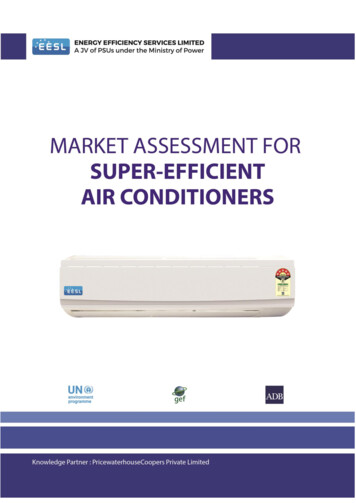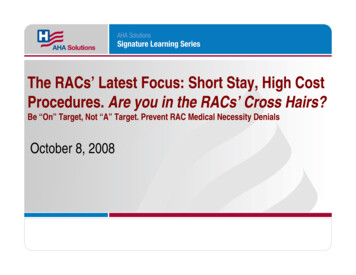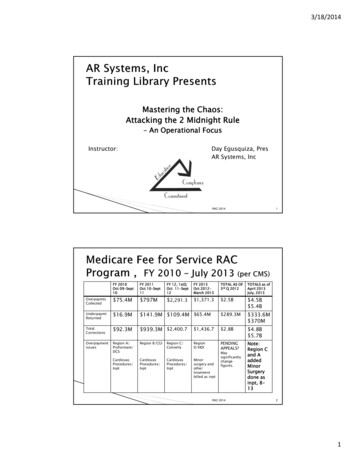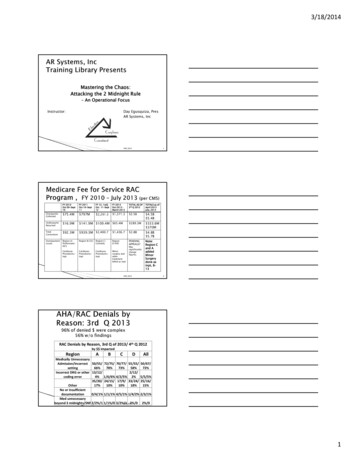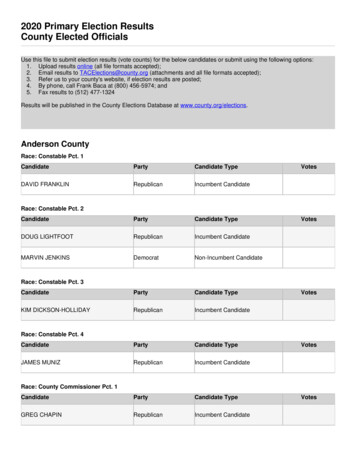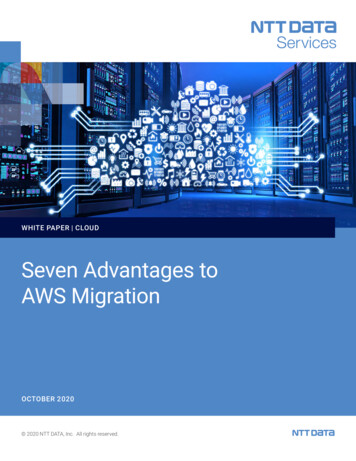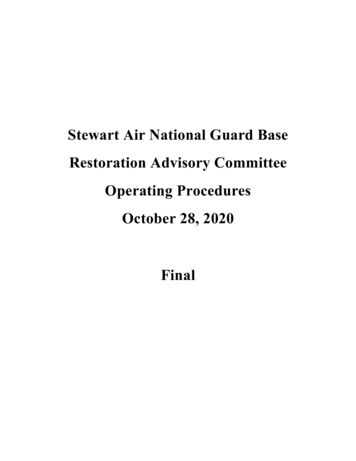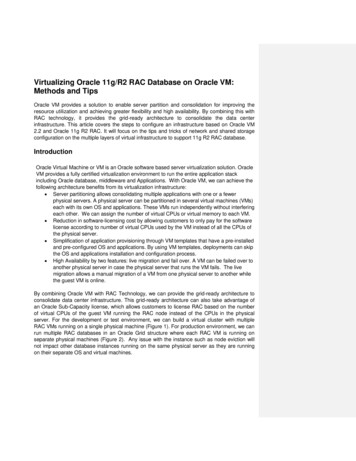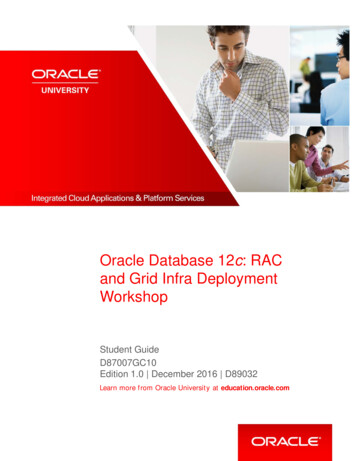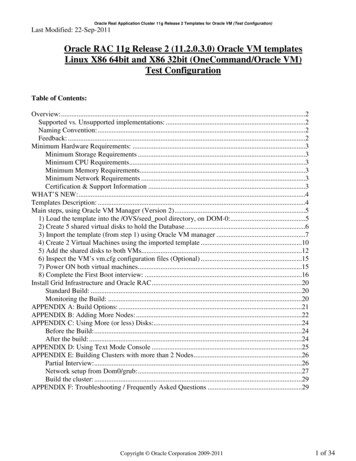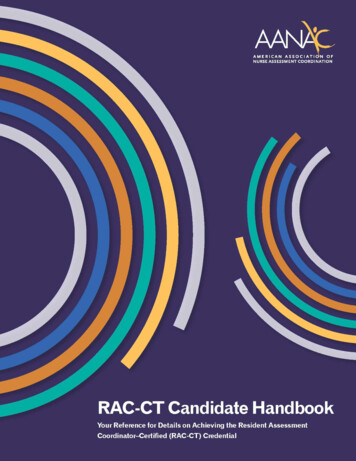
Transcription
RAC-CT Candidate HandbookDisclaimerAAPACN certifications and educational courses were developed to serve as programs and references for longterm care. To the best of our knowledge, they reflect current federal regulations and practices. However, theycannot be considered absolute and universal. The information in these courses must be considered in light ofthe individual organization and state regulations.The authors and publisher disclaim responsibility for any adverse effects resulting directly or indirectly fromthe use of the course material, from any undetected errors, and from the user’s misunderstanding of the text.The authors and publisher put forth every effort to ensure that the content, including any policies,recommendations, and sample documents used in these courses, was in agreement with current federalregulations, recommendations, and practices at the time of publication.This handbook reflects the policies and procedures as of April 2021 All policies and procedures are subject tochange. If you have any questions or require further information, visit www.AAPACN.org or contact AAPACNstaff toll-free at (800) 768-1880.Statement of nondiscriminationThe opportunity to earn the AAPACN credentials is available to all candidates who meet the minimum criteria.AAPACN does not discriminate on the basis of age, gender, race, religion, national origin, marital status, sexualpreference, or disability.CopyrightCopyright 2021, American Association of Post-Acute Care Nursing.All Rights Reserved.No part of this publication may be reproduced or transmitted in any form or by any means (electronic ormechanical, by photocopying or otherwise), without permission in writing from AAPACN. For informationcontact AAPACN, 400 S. Colorado Blvd., Suite 600, Denver, CO 80246. Phone: toll-free (800) 768-1880.Published by AAPACN.Customer Service: toll-free (800) 768-1880 Fax: (303) 758-3588www.AAPACN.orgAccreditationAmerican Association of Post-Acute Care Nursing (AAPACN) is accredited as a provider of nursing continuingprofessional development by the American Nurses Credentialing Center’s Commission on Accreditation.1
RAC-CT Candidate HandbookResident Assessment Coordinator–Certified (RAC-CT)Candidate HandbookTable of ContentsWelcome . 3About AAPACN . 3How to use this Candidate Handbook. 3Overview . 4What is the purpose of RAC-CT certification and educational courses? . 4What are the benefits of certification and education?. 4Who is eligible to take the exams? . 4How do I register for certification and education? . 4How much does education, certification, and recertification cost? . 5Getting Ready for the Exam . 5RAC-CT Body of Knowledge. 5What is the format of the exam? . 8How do I prepare for the exam? . 8How are reasonable accommodations made?. 9Taking the Exam . 9What are the requirements during the exam? . 9How long do I have to complete a course/exam? . 9After the Test . 10How is my information kept confidential? . 10How is the exam scored? . 10What information will I receive about my score? . 10When will I receive my score?. 11Can I retake the exam if I don’t pass? . 11Is there an appeals provision? . 11Recertification: Certification Maintenance . 11When do I need to recertify? . 11What are the recertification requirements? . 12How much does RAC-CT recertification cost? . 12What if I let my certification lapse? . 122
RAC-CT Candidate HandbookWelcomeCongratulations on taking the first step toward earning the Resident Assessment Coordinator–Certified (RACCT) credential. The American Association of Post-Acute Care Nursing (AAPACN) established the certificationprogram in 1999 to promote the highest standards for clinical assessment and care planning in the long-termcare profession. Reviewing this handbook is the first step toward joining long-term care professionals whohave distinguished themselves with certified knowledge of the Resident Assessment Instrument/MinimumData Set (RAI/MDS 3.0) process.About AAPACNThe American Association of Post-Acute Care Nursing (AAPACN) represents more than 15,000 post-acute carenurses and professionals working in more than 5,750 facilities. Dedicated to supporting LTPAC nurses andhealthcare professionals in providing quality care, AAPACN offers members best in-class education,certification, resources, and strong collaborative communities.Whether you’re looking to earn one of our respected certifications or just want to brush up your knowledge bytaking a course or two, AAPACN keeps you up to date and makes the complexities of long-term care easy tounderstand.How to use this Candidate HandbookThis handbook is intended to help you understand the policies and procedures for RAC-CT certification and thesteps required to earn and maintain your credential. This handbook is also intended to help you learn aboutRAC-CT education. Once you decide to pursue the RAC-CT credential, this Candidate Handbook will be a usefulreference to you as you: Review the RAC-CT Body of KnowledgeAssess your knowledge and professional experience of the contentIdentify gaps in knowledge and develop a personal course of studyStudy, prepare for, and take the RAC-CT examinationsMaintain your credential through recertificationAAPACN’s educational materials are reviewed and updated by a team of experts to ensure you receive themost up-to-date information related to this complex body of knowledge. No document can address the full listof potential questions, policy details, or future program changes. You are encouraged to use this handbook asa supplement to the information listed on the AAPACN website as well as information provided by AAPACNstaff, whom you can contact toll-free at (800) 768-1880.3
RAC-CT Candidate HandbookOverviewWhat is the purpose of RAC-CT certification and educational courses?RAC-CT certification and education have long set the national standard for knowledge of the Skilled NursingFacility Prospective Payment System (SNF PPS) and MDS 3.0. AAPACN serves the public interest by developing,administering, and reviewing a certification process that reflects current standards of competent performancein clinical assessment and care planning using the RAI/MDS process. Whereas the fundamental concept of theRAI/MDS process is to promote quality of care and quality of life for residents in skilled nursing facilities, thegoal of RAC-CT certification and education is to establish that nurses have the knowledge and skills necessaryto demonstrate competence in this area.What are the benefits of certification and education?Upon completion of the 10 RAC-CT courses, and after passing the exams with a score of 80% or better, you willbe allowed to use the initials RAC-CT to designate your status. This designation indicates you have met anationally recognized standard of expertise in SNF PPS and MDS 3.0 assessments.Both individuals and employers can benefit from an individual’s receiving RAC-CT certification.Individual professional benefits can include: Verification by an independent organizationof your mastery of the knowledge requiredto perform your jobProfessional growth and developmentEnhanced job opportunitiesOrganizational benefits can include: Increased productivity, as the RAI/MDSprocess is properly implementedLess training time needed to educateemployees on the complex Medicareregulations and proceduresAccurate billing, leading to full receipt ofMedicare funds for services providedWho is eligible to take the exams?AAPACN encourages all members of the interdisciplinary team to seek RAC-CT certification: RNs, LPNs, LVNs,nurse assessment coordinators, physical therapists, occupational therapists, speech therapists, social workers,health information professionals, dietitians, and administrators.AAPACN recommends that individuals have at least six months of experience with the RAI/MDS process beforebeginning the certification process. If you have less than six months of experience, consider the MDS 3.0Essentials On-Demand Workshop and also gaining practical experience in your long-term care facility.How do I register for certification and education?To purchase the RAC-CT courses and exams in the format most beneficial to you, visit the AAPACN website.4
RAC-CT Candidate HandbookHow much does education, certification, and recertification cost?The RAC-CT program consists of 10 courses, offered in several formats to support various learning styles. Theassociated certification exams are included with the purchase of each educational course. Recertificationrequires purchasing two recertification courses and passing the associated exams with a score of 80% orhigher. Pricing is based on cost per course and varies by format. AAPACN members receive substantialdiscounts.Getting Ready for the ExamRAC-CT Body of KnowledgeAAPACN undertook a rigorous process with numerous experts in the profession to determine the domains andtasks within the RAC-CT Body of Knowledge, in terms of both criticality and importance. The domain emphasisreflects the percentage of questions that come from each domain.The 10 RAC-CT examinations, and associated education, are designed for long-term care professionals with atleast six months of experience with the RAI/MDS process.If you have less than six months of experience, consider the MDS 3.0 Essentials On-Demand Workshop andgaining practical experience in your long-term care facility.RAC-CT Body of Knowledge Domain 1 – MDS 3.0 Coding for OBRA and PPS (Domain Emphasis: 26%)o Perform an accurate assessment using the Resident Assessment Instrument (RAI) process andthe Minimum Data Set (MDS). Understand the intent of each MDS item as it relates toeffective care planning, accurately code each item of the MDS, and understand the effects ofinaccurate MDS coding.oTasks: Part 1 Course Demonstrate an understanding of the background of the regulatoryrequirement and the purpose of the RAI/MDS process Section A: Identification Information Section B: Hearing, Speech, and Vision Section C: Cognitive Patterns Section D: Mood Section E: Behavior Section F: Preferences for Customary Routine and Activities Section G: Functional Status Section GG: Functional Abilities and Goals5
RAC-CT Candidate Handbook Domain 2 – Accurately assessing functional status and the MDS 3.0 (Domain Emphasis: 7%)o Utilize the Minimum Data Set (MDS) screening tool to accurately assess a resident’s functionalstatus, determine a resident-directed approach to care planning, and ensure the residentattains and maintains his or her highest level of function.o Part 2 Course Section H: Bladder and Bowel Section I: Active Diagnoses Section J: Health Conditions Section K: Swallowing/Nutritional Status Section L: Oral/Dental Status Section M: Skin Conditions Section N: Medications Section O: Special Treatments, Procedures, and Programs Section P: Restraints and Alarms Section Q: Participation in Assessment and Goal Setting Section V: Care Area Assessment Summary Section X: Correction Request Section Z: Assessment AdministrationTasks: Identify the components of overall functional assessment Accurately code MDS Section G: Functional Status Implement the process of determining an appropriate, resident-directed approach tocare planning for functional status Understand how functional status is used in the survey process to trigger furtherinvestigation of decline in residentsDomain 3 – Managing the Patient-Driven Payment Model (PDPM) in a Skilled Nursing Facility (SNF)(Domain Emphasis: 10%)o Increase the knowledge and skills required to understand the Skilled Nursing FacilityProspective Payment System (SNF PPS)—the method of payment used for skilled nursingfacilities. The focus of this educational course is the Skilled Nursing Facility ProspectivePayment System (SNF PPS).oTasks: Describe the methodology and philosophy of the SNF PPS and the general frameworkof PDPM Understand the six components of PDPM Calculate the daily per diem under PDPM Understand the PPS assessment schedule Delineate administrative presumption of the skilled level of care Identify the connection between the MDS and PDPM Recognize the ongoing monitoring and oversight of therapy provisions by CMS6
RAC-CT Candidate Handbook Domain 4 – OBRA timing and scheduling for the MDS 3.0 (Domain Emphasis: 11%)o Understand the requirements for scheduling and timing OBRA-required MDS assessments.o Tasks: Understand the role and process of CAAs Conduct CAAs Apply CAA documentation requirements, including assessment findings and daterequirements for Section V: Care Area Assessment SummaryDomain 6 – Care planning and the MDS 3.0 (Domain Emphasis: 7%)o Develop an individualized, interdisciplinary care plan designed to address the resident’sspecific problems, risk factors, and complications, with the goal of attaining and maintainingthe highest practicable physical, mental, and psychosocial well-being for the resident.o Understand the timing of OBRA-required assessmentsDifferentiate between and accurately manage assessment time framesAccurately conduct Significant Change of Status Assessments (SCSA)Accurately conduct Significant correction to prior comprehensive assessmentsAccurately conduct Discharge assessments, Entry records, and tracking recordsDomain 5 – Care Area Assessments (CAAs) and the MDS 3.0 (Domain Emphasis: 6%)o Implement the process of the CAAs, the 20 care areas, CAA documentation requirements,timing requirements for completion, and related MDS items.o Tasks: Tasks: Understand the purpose and foundation of the care planning process to effectivelyapply critical-thinking skills Develop a care plan Apply appropriate time frames and allow updates and revisions to the care planaccording to the resident’s changing needsDomain 7 – Quality Measures and the MDS 3.0 (Domain Emphasis: 9%)o Understand the Quality Measures, including how they are calculated; identify the MDS itemsthat drive the Quality Measures; and accurately code the MDS to improve the quality of care innursing facilities.oTasks: Demonstrate an understanding of the role and objectives of the Quality Measures inthe Nursing Home Quality Initiative and for the survey process Demonstrate an understanding of Quality Measure concepts, assessment definitions,and components of the calculation Manage the Quality Measures with effective processes to achieve high-quality residentcare and competitive QM scores7
RAC-CT Candidate Handbook Domain 8 – The Five-Star Quality Rating System (Domain Emphasis: 10%)o Understand how the Five-Star Quality Rating System is designed to help individuals, familymembers, caregivers, and the public find and compare the quality of nursing facilities; identifyhow to improve the rating for your facility.o Tasks: Demonstrate an understanding of the purpose and background of the Five-Star QualityRating System Demonstrate an understanding of the Survey star rating Demonstrate an understanding of the Staffing star rating Demonstrate an understanding of the Quality Measures star rating Identify how to proactively manage and improve your facility's Five-Star rating withthe goal of improving resident careDomain 9 – Introduction to Medicare Part A (Domain Emphasis: 12%)o Understand Medicare Part A coverage and the facility’s responsibilities for managing theMedicare benefit, making appropriate coverage decisions, and maintaining compliance as aMedicare provider; understand the facility’s responsibility when a resident is denied coverage.oTasks: Demonstrate an understanding of Medicare Part A coverage, managing the Medicarebenefit, and making appropriate coverage decisions Demonstrate an understanding of the medical review process and procedures formanaging claimsWhat is the format of the exam?A certification exam accompanies each course and is completed online and accessed through your LearnerDashboard on the AAPACN website. The certification exams are an objective, multiple-choice question format.The questions are designed to test your recall of specific knowledge, as well as your ability to analyze andapply that knowledge to example situations. It is not a timed test. The questions test knowledge of thedomains and tasks in the RAC-CT Body of Knowledge. The domain emphasis reflects the percentage ofquestions that comes from each domain. You will be asked to select the correct or best answer from fouroptions. Only one answer is correct for every question.How do I prepare for the exam?Content for examinations is not obtained from any one particular source. The RAC-CT Body of Knowledgeshould be a guideline for study preparation. The educational materials from the online curriculum, as well aslive workshops, provide a basis of knowledge for exam preparation. You should also utilize current journals,textbooks, source documents like the MDS 3.0 RAI User’s Manual, and other reference material related to thesubjects listed in the Body of Knowledge as supplemental preparatory materials for the exam.After reviewing the Body of Knowledge, you can plan your exam preparation based on your generalunderstanding and working knowledge of the subject areas. For example, because of daily use at your currentjob, you may have a good understanding and working knowledge of some of the domain areas—these areasmay need only a quick review as you prepare for the test. For areas with which you are less familiar, you maydecide you need more in-depth study or training before completing the certification exam; you can allocateyour study time appropriately.8
RAC-CT Candidate HandbookYou should also consider what percentage of the test questions will cover each major content area; thisinformation is listed as the domain emphasis percentage in the Body of Knowledge section of this handbook.By focusing your studies, you can spend extra time as needed to thoroughly understand the most significantsources of content area on the exam. Sample exam questions and answers are listed in the Resources sectionof this handbook as an additional study aid.How are reasonable accommodations made?If you require reasonable accommodations to complete the certification exams for the program, pleasecontact AAPACN toll-free at (800) 768-1880, or by email at education@AAPACN.org.Taking the ExamWhat are the requirements during the exam?AAPACN assigns you a username and password as a key control in monitoring and verifying user identity in theLearner Dashboard area of the AAPACN website. This log-in information helps ensure that each user’sinformation is available only to the authorized user. As a user of the Learner Dashboard, it is important thatyou do not share this username and password with anyone. You should be the only one to access andcomplete your exam and course material in your Learner Dashboard.Once you begin each certification exam, you may complete it either in one sitting or in sections. It is an openbook format, so you may use reference materials when you take the exam. However, you cannot seekassistance from other individuals while completing the exam. The exams are offered on an honor-system basisthat assumes you will act in good faith to ensure your performance is an accurate representation of your ownpersonal knowledge and skills related to the subject matter.AAPACN does not tolerate cheating or any breach of academic or professional ethics that may compromise thesecurity or integrity of its certification exams. All incidents of reported cheating will be investigated. Discussingcontent found on the certification exams is strictly prohibited; any such posts on Community discussion boardswill be removed. Anyone found compromising the security of the exams by attempting to copy, record, ordistribute questions in any manner will be permanently excluded from the certification process.How long do I have to complete a course/exam? Online course(s) and certification examinations – The educational courses and certification exams arecompleted through your Learner Dashboard. The courses are offered in a self-paced interactive onlineformat. The exams are not timed, and you may exit the exam and return at a later time to complete it.Your courses and exams expire one year after purchase. After the one-year expiration date, you willlose access to the course and exam content. Live workshop and certification examinations– The educational content is presented during the liveworkshop dates. You will take the certification exams separately through your Learner Dashboard.These are not timed, and you may exit the exam and return at a later time to complete it. Your coursesand exams expire one year after purchase. After the one-year expiration date, you will lose access tothe course and exam content.9
RAC-CT Candidate Handbook Printed manuals and certification examinations– The educational content is presented in a printedformat, shipped directly to you. You will take the certification exams separately through your LearnerDashboard. These are not timed, and you may exit the exam and return at a later time to complete it.Your courses and exams expire one year after purchase. After the one-year expiration date, you willlose access to the course and exam content. Exam attempts – You have three attempts per course to pass the certification exams with a score of80% or better. The exam itself is not timed, and you do not have to complete it in one sitting. If youhave exhausted all exam attempts, you may request additional attempts one time per course. If yourrequest is approved, you will receive an additional three exam attempts. If you do not pass after sixattempts, you must wait one year before taking the certification exams again.In the case of an extenuating circumstance, you can submit a formal, written appeal to request anexception to the policy. To begin the appeals process, login to your Learner Dashboard and click on the“Apply for Appeal” link in the menu on the left-hand side of the site.After the TestHow is my information kept confidential?Information about candidates and their examination results is confidential. AAPACN carefully protects yourdata from loss, misuse, unauthorized access or disclosure, alteration, or destruction. Within the company, datais stored in password-controlled servers with limited access. Your personal information is never shared outsidethe company without your permission, unless required by law to comply with a current judicial proceeding,court order, or legal process. If AAPACN is required by law to release your confidential information, you will benotified by email, unless prohibited by law.How is the exam scored?The RAC-CT exams, as well as RAC-CT courses and workshops, set a standard of basic levels of knowledge thatcan reasonably be expected of long-term care professionals involved in the RAI/MDS process. Yourperformance on the exams will be measured against this predetermined standard to assess your competencyin these subject matters. Your performance will not be measured against other candidates taking thecertification exams; your individual performance will determine whether you meet the knowledge standardsrequired to pass.What information will I receive about my score?Once you have completed the examination, you will be presented with the percentage of questions correctlyanswered. Based on the percentage, your exam results will indicate “pass” or “fail.” You must achieve a scoreof 80% or better to pass the exam.You will not see the correct answers to missed questions on the exam results. To protect the confidentiality ofthe exam content, and to maintain the value and integrity of the certification, AAPACN does provide domainlevel feedback. The certification exam is intended to measure proficiency in the subject and to determinewhether an individual has the knowledge necessary for certification.10
RAC-CT Candidate HandbookWhen will I receive my score?The certification exams are self-scoring and provide immediate feedback. Upon completion of the exam, yourcomputer screen will display the percentage of correctly answered questions and indicate “pass” or “fail.” Youmay access this information at a later date by logging into your Learner Dashboard.Once you pass 10 certification exams, you may begin using the initials RAC-CT to designate your status as acertified Resident Assessment Coordinator. Credentials are awarded for a two-year period.Can I retake the exam if I don’t pass?You have three attempts to pass the certification exam with a score of 80% or better. If you have exhausted allexam attempts, you may request additional attempts one time per course. If your request is approved, you willreceive an additional three exam attempts. If you do not pass after six attempts, you must wait one yearbefore taking the certification exams again.In the case of an extenuating circumstance, you can submit a formal, written appeal to request an exception tothe policy. To begin the appeals process, login to your Learner Dashboard and click on the “Apply for Appeal”link in the menu on the left-hand side of the site.Is there an appeals provision?AAPACN works diligently to provide top-quality course materials and exams using a standardized process ofquestion development and validation. AAPACN also affords candidates a high level of flexibility in completingthe exam. Due to these policies and procedures, an appeal will be heard only in the case of an extenuatingcircumstance. In this case, you may submit a formal, written appeal to AAPACN to request an exception to thepolicy. To begin the appeals process, login to your Learner Dashboard and click on the “Apply for Appeal” linkin the menu on the left-hand side of the site.Recertification: Certification MaintenanceWhen do I need to recertify?The RAC-CT certification is valid for two years from your certification completion date. Your credential expirestwo years from when you completed your exam requirements. Your exact expiration date can be found in yourLearner Dashboard, in the Certifications section. You must complete your recertification requirements by theexpiration date of your credential. If you do not complete the recertification requirements by your certificationexpiration date, you will be required to re-start the full program to regain your certification at a later date.11
RAC-CT Candidate HandbookWhat are the recertification requirements?To maintain your RAC-CT certification, you must recertify every two years. To recertify you must take and passtwo recertification exams and courses: RAC-CT 3.0 Recertification: MDS 3.0 Updates and Managing PDPM inthe Skilled Nursing Facility, and RAC-CT 3.0 Recertification: MDS 3.0 Common Coding Errors and QualityMeasure Pitfalls 1.2. Alternatively, you can complete the 10-course RAC-CT program again.Each rece
steps required to earn and maintain your credential. This handbook is also intended to help you learn about RAC-CT education. Once you decide to pursue the RAC-CT credential, this Candidate Handbook will be a useful reference to you as you: Review the RAC-CT Body of Knowledge Assess your knowledge and professional experience of the content
